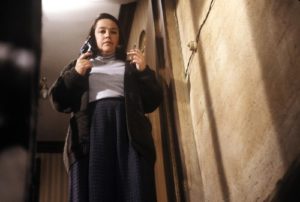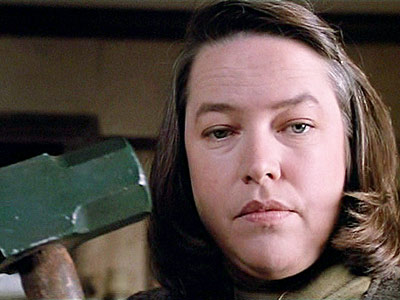In “Misery,” a famous novelist’s car crashes in the remote winter mountainside, and he is nursed back to health by an unstable woman who bills herself as his “Number 1 fan.” Of course the book this film is based on is of the same name and written by Stephen King. We see that King, as with “Cujo,” another of his novels, can find horror in any situation, even confined to one small space. In “Cujo” it was the front seat of a small car; in “Misery” it is one bedroom in the woman’s desolate house. The woman is named Annie, and is played by Kathy Bates with a skill so sharp it won her a 1991 Academy Award for “Best Actress in a Leading Role.”
“Misery” follows suit of that type of horror film that is slow to build, and the tension comes from knowing that something bad will happen, just not what and when. Watching this film, it’s clear that John Goodman’s performance in the excellent “10 Cloverfield Lane” was inspired by Bates’ role in “Misery;” she is a ticking time bomb waiting to explode. And, in the way of skilled horror, that time bomb is kept ticking as long as physically possible before setting it off, ratcheting up our nerves as the film slowly progresses.
A hefty suspension of disbelief, of course, is necessary to make this movie work. The writer in this film, Paul Sheldon, is played by James Caan, better known for his role in “The Godfather” and lesser known for his roles in subsequent movies such as “Elf” and “Eraser.” He delivers his lines with dry, sarcastic slickness, unaware of the danger he’s in, hoping his impressive career and New York City living will carry him through this unfortunate set of events. But he’s broken both his legs, “compound fractures” Annie tells him, and is slowly brought back to health by Annie, whom tells him she is, besides his number one fan, a nurse.

Little explanation is given for how Paul’s injuries, which clearly only a visit to a hospital would aid in, seem to heal over the course of this movie.
Some of King’s best efforts work off as few characters as possible, and “Misery” is no exception. “The Shining’s” horror worked off of only three, and here the eerie atmosphere is crafted with just Paul and Annie, not even a pet lurking around the house to break the tension that hides behind the silence.
The film is directed by Rob Reiner, and works due to his formulaic slow-to-build progression, and the plausible explanation he gives to Paul’s incapacity. The film also works due to the rapport that Bates and Caan have with both each other and the subject material, and that they play off of each other in believable ways. The horror of their encounters lies in that 90% of their interactions are pleasant, and you never know when Bates will bring her alter personality into the other 10%.
Two scenes are the scariest: one, as she critiques Paul’s latest novel, lashing out at him for his use of profanity, and the second as she later believes Paul may be trying to escape. Neither one you see coming; and the effect both play on the viewers’ nerves are executed to perfection.
There are some ancillary characters in this film, such as Richard Farnsworth who plays the town sheriff, and Frances Sternhagen, who plays his wife, that break up some of the material and advance the plot. But the real show here is between Bates and Caan, and both own up to their end flawlessly. Caan plays the part of the victim, and his true acting achievement here is that, for most of the film, he acts and believes that he is not a victim. His awareness comes slowly, and Caan makes us believe the transition.
 Bates here is stellar. Appearances in other films, such as “Titanic,” or “Tammy” do nothing to prepare one for the acting chops she brings to the table here. She’s delusional, sociopathic, explosive. Her demeanor makes you believe she’s a truly terrifying entity, a demeanor backed up by secondary props such as ghastly newspaper clippings Sheldon finds laying around her house. She truly makes this movie. Without Kathy Bates’ performance, there could be no “Misery.”
Bates here is stellar. Appearances in other films, such as “Titanic,” or “Tammy” do nothing to prepare one for the acting chops she brings to the table here. She’s delusional, sociopathic, explosive. Her demeanor makes you believe she’s a truly terrifying entity, a demeanor backed up by secondary props such as ghastly newspaper clippings Sheldon finds laying around her house. She truly makes this movie. Without Kathy Bates’ performance, there could be no “Misery.”
“Misery” is a solid horror film. With good acting, a creepy atmosphere, and tension throughout, it’s a practitioner in terror and suspense in the old school.
– by Mark Ziobro


